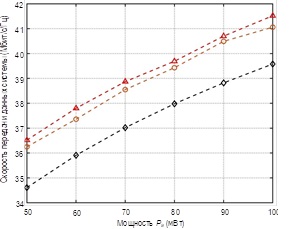
Resource Optimization of Airborne Base Stations Using Artificial Intelligence Methods
https://doi.org/10.31854/1813-324X-2025-11-1-62-68
EDN: RVENVC
Abstract
In remote areas and disaster-stricken regions, unmanned aerial vehicles (UAVs) can serve as base stations, providing wireless communication to ground users. Due to their high mobility, low cost, and rapid deployment and retrieval capabilities, UAVs can continuously adjust their position in three-dimensional (3D) space, improving wireless connectivity and enhancing data transmission rates. In this paper, we investigate the problem of ABS (Aerial Base Station) deployment in 3D space and power allocation with the aim of maximizing the data transmission rate in the system. To address this non-convex problem, we propose Q-learning, a reinforcement learning algorithm. By using the ABS as an agent, the algorithm enables the ABS to explore the state space and take actions based on an ϵ-greedy policy (optimal epsilon value) to determine its 3D position and power allocation. Simulation results demonstrate that the proposed algorithm outperforms individual position optimization and power allocation optimization.
The purpose of this article is to study the efficiency of using modern artificial intelligence methods to optimize the use of resources of airborne base stations of public communication networks.
The essence of the proposed solution is to use modern artificial intelligence methods, namely: the Q-learning method and the epsilon-greedy ϵ-greedy algorithm to ensure joint optimization of the placement of airborne base stations and power distribution to maximize the data transfer rate. The system has an implementation in the form of a simulation program. Simulation experiments have shown that the use of the Q-learning reinforcement learning method and the epsilon-greedy e-greedy algorithm for joint optimization provides a higher overall data transfer rate in the system compared to optimizing only the location or power distribution.
The scientific novelty of the proposed solution is that joint optimization of the placement of an airborne base station and power distribution made it possible, in contrast to known results, to establish that the flight altitude of a UAV with a base station installed on it when optimizing only the location will be higher than the flight altitude of a UAV when jointly optimizing the location and power distribution.
The practical significance is the possibility of developing a methodology for planning public communication networks using airborne base stations to obtain a higher overall data transfer rate on the corresponding network fragment.
About the Authors
T. D. TranRussian Federation
A. E. Koucheryavy
Russian Federation
References
1. Ding G., Wu Q., Zhang L., Lin Y., Tsiftsis T.A., Yao Y.D. An amateur drone surveillance system based on the cognitive Internet of Things. IEEE Communications Magazine. 2018;56(1):29‒35. DOI:10.1109/MCOM.2017.1700452. EDN:YBEOMH
2. Rose K., Eldridge S., Chapin L. The internet of things: An overview. The internet society (ISOC). 2015;80(15):1‒53.
3. Zhao N., Lu W., Sheng M., Chen Y., Tang J., Yu F.R., et al. UAV-Assisted Emergency Networks in Disasters. IEEE Wireless Communications. 2019;26(1):45‒51. DOI:10.1109/MWC.2018.1800160
4. Li B., Fei Z., Zhang Y. UAV communications for 5G and beyond: Recent advances and future trends. IEEE Internet of Things Journal. 2018;6(2):2241‒2263. DOI:10.1109/JIOT.2018.2887086. EDN:UPZMGQ
5. Shannon C.E. A mathematical theory of communication. The Bell System Technical Journal. 1948;27(3):379‒423. DOI:10.1002/j.1538-7305.1948.tb01338.x
6. Sutton R.S. Reinforcement learning: An introduction. The MIT Press; 2018.
7. Jaakkola T., Jordan M., Singh S. Convergence of Stochastic Iterative Dynamic Programming Algorithms. Advances in Neural Information Processing Systems 6 (NIPS 1993). 1993.
8.
Review
For citations:
Tran T.D., Koucheryavy A.E. Resource Optimization of Airborne Base Stations Using Artificial Intelligence Methods. Proceedings of Telecommunication Universities. 2025;11(1):62-68. (In Russ.) https://doi.org/10.31854/1813-324X-2025-11-1-62-68. EDN: RVENVC


































